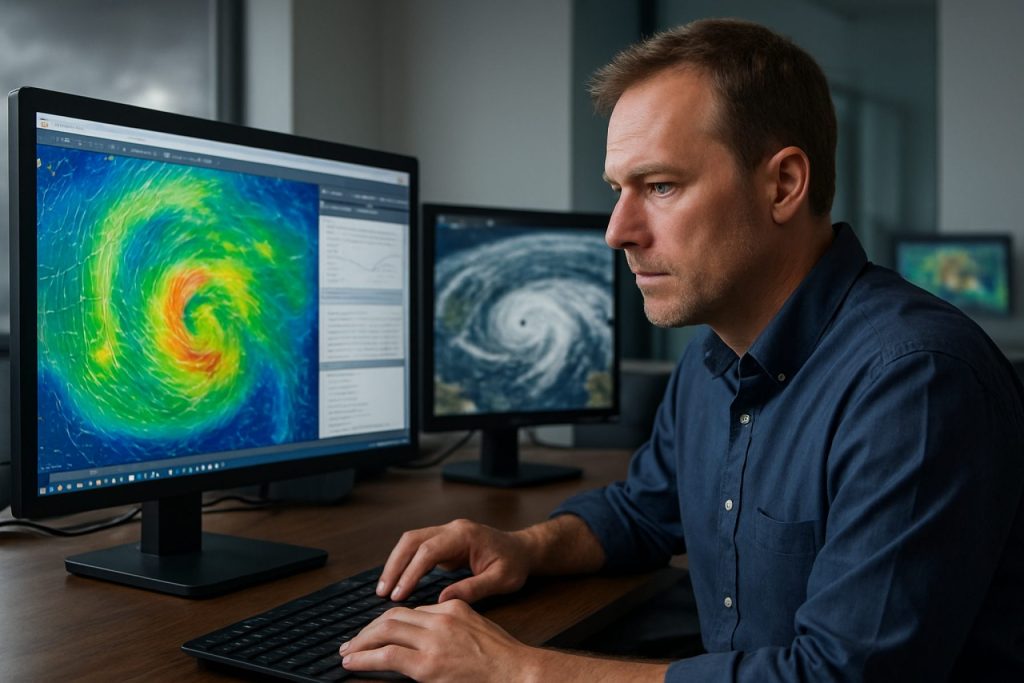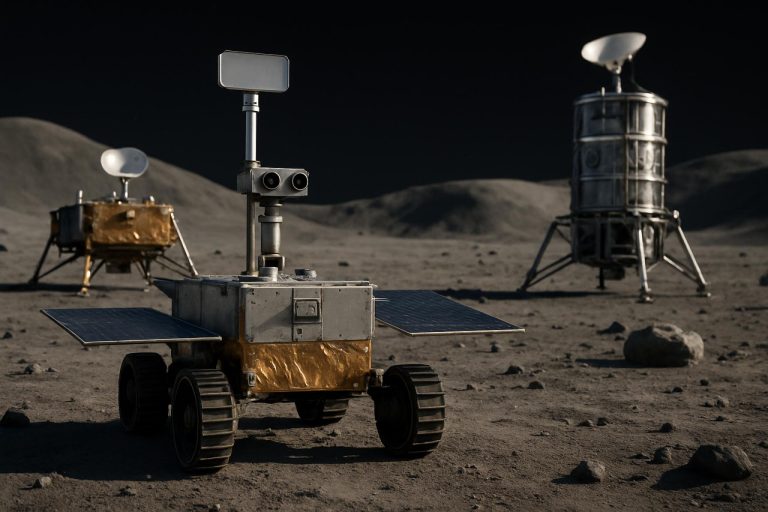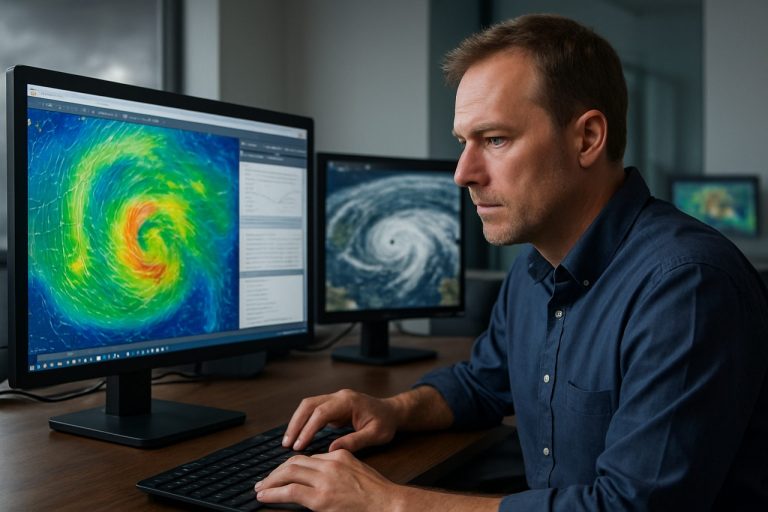
Atmospheric & Weather Modeling Software in 2025: Unleashing Precision, AI, and Global Impact. Explore How Next-Gen Tools Are Transforming Forecasting and Industry Growth.
- Executive Summary: 2025 Market Highlights and Key Drivers
- Industry Overview: Evolution of Atmospheric & Weather Modeling Software
- Market Size and Growth Forecast (2025–2030): CAGR and Revenue Projections
- Key Players and Competitive Landscape (e.g., esrl.noaa.gov, metoffice.gov.uk, dwd.de)
- Technological Innovations: AI, Machine Learning, and Cloud Integration
- Application Sectors: Aviation, Agriculture, Energy, and Disaster Management
- Regional Analysis: North America, Europe, Asia-Pacific, and Emerging Markets
- Challenges and Barriers: Data Quality, Computational Demands, and Integration
- Regulatory Environment and Industry Standards (e.g., wmo.int, ecmwf.int)
- Future Outlook: Disruptive Trends and Strategic Opportunities Through 2030
- Sources & References
Executive Summary: 2025 Market Highlights and Key Drivers
The atmospheric and weather modeling software market in 2025 is characterized by rapid technological advancements, increased demand for high-resolution forecasting, and a growing emphasis on climate resilience. Key drivers include the proliferation of extreme weather events, the need for accurate short- and long-term forecasts, and the integration of artificial intelligence (AI) and machine learning (ML) into modeling platforms. These trends are shaping the strategies of leading organizations and fostering new collaborations across the public and private sectors.
Major players such as IBM, through its The Weather Company division, continue to expand their suite of weather analytics and forecasting tools, leveraging AI to deliver hyper-local predictions for industries ranging from agriculture to aviation. Similarly, Esri integrates atmospheric data into its geographic information system (GIS) platforms, enabling users to visualize and analyze weather impacts in real time. The adoption of cloud-based solutions is accelerating, with providers like Microsoft and Amazon offering scalable infrastructure for running complex weather simulations and storing vast datasets.
Government agencies and research institutions remain at the forefront of model development. The National Oceanic and Atmospheric Administration (NOAA) is advancing its Unified Forecast System (UFS), aiming for improved accuracy and efficiency in operational weather prediction. The European Centre for Medium-Range Weather Forecasts (ECMWF) is deploying its next-generation Integrated Forecasting System (IFS), which incorporates higher-resolution data and enhanced data assimilation techniques. These efforts are supported by international collaborations and open data initiatives, fostering innovation and interoperability across platforms.
In 2025 and the coming years, the market outlook is shaped by several key trends:
- Increased investment in AI/ML-driven modeling to enhance forecast precision and automate data analysis.
- Expansion of cloud-native weather modeling platforms, reducing barriers to entry for smaller organizations and startups.
- Growing demand from sectors such as renewable energy, insurance, and transportation for tailored, actionable weather insights.
- Emphasis on climate adaptation and disaster risk reduction, driving the need for integrated, scenario-based modeling tools.
As the impacts of climate change intensify, the atmospheric and weather modeling software sector is poised for continued growth and innovation. Strategic partnerships between technology providers, research agencies, and end users will be critical in delivering the next generation of forecasting solutions and supporting global resilience efforts.
Industry Overview: Evolution of Atmospheric & Weather Modeling Software
The atmospheric and weather modeling software sector has undergone significant transformation, driven by advances in computational power, data assimilation techniques, and the integration of artificial intelligence (AI). As of 2025, the industry is characterized by a blend of established meteorological institutions, innovative technology companies, and collaborations with governmental agencies, all working to enhance the accuracy, speed, and accessibility of weather prediction.
Historically, weather modeling relied on deterministic numerical weather prediction (NWP) models, which required supercomputing resources and were primarily operated by national meteorological agencies. Today, leading organizations such as European Centre for Medium-Range Weather Forecasts (ECMWF) and National Oceanic and Atmospheric Administration (NOAA) continue to set global standards, running high-resolution global and regional models that assimilate vast quantities of satellite, radar, and in-situ data. ECMWF’s Integrated Forecasting System (IFS) and NOAA’s Global Forecast System (GFS) are among the most widely used platforms, with ongoing upgrades to leverage exascale computing and machine learning for improved forecast skill.
The private sector has become increasingly influential, with companies like IBM (through its acquisition of The Weather Company) and Tomorrow.io (formerly ClimaCell) developing proprietary modeling frameworks and hyperlocal forecasting solutions. IBM’s GRAF (Global High-Resolution Atmospheric Forecasting) system, for example, delivers hourly-updating, high-resolution forecasts globally, utilizing both traditional NWP and AI-driven post-processing. Tomorrow.io’s platform emphasizes rapid-update, customizable models for industries such as aviation, logistics, and energy, reflecting a broader trend toward tailored, sector-specific weather intelligence.
Open-source initiatives and cloud-based delivery are also reshaping the landscape. The Unidata Program Center (part of the University Corporation for Atmospheric Research) supports community-driven software like the Weather Research and Forecasting (WRF) model, which is widely adopted for academic, governmental, and commercial applications. Cloud providers, including Microsoft and Amazon, are increasingly hosting weather modeling tools and datasets, enabling scalable, on-demand access for users worldwide.
Looking ahead, the next few years are expected to see further convergence of AI, big data, and high-performance computing in atmospheric modeling. Initiatives such as digital twin Earth projects and the integration of non-traditional data sources (e.g., IoT sensors, commercial aircraft observations) are poised to enhance model fidelity and real-time responsiveness. As climate change intensifies the demand for accurate, actionable weather information, the industry is likely to witness continued innovation and cross-sector collaboration, with both public and private actors playing pivotal roles.
Market Size and Growth Forecast (2025–2030): CAGR and Revenue Projections
The global market for atmospheric and weather modeling software is poised for robust growth between 2025 and 2030, driven by increasing demand for accurate weather prediction, climate risk assessment, and real-time data analytics across sectors such as agriculture, aviation, energy, and disaster management. The proliferation of high-performance computing (HPC), cloud-based solutions, and artificial intelligence (AI) integration is further accelerating market expansion.
Industry leaders such as IBM (through its IBM Environmental Intelligence Suite and The Weather Company), Esri (with ArcGIS for environmental modeling), and Vaisala (offering weather and environmental measurement solutions) are investing heavily in R&D to enhance model accuracy, scalability, and accessibility. Open-source platforms and collaborations, such as those led by the European Centre for Medium-Range Weather Forecasts (ECMWF) and the National Oceanic and Atmospheric Administration (NOAA), are also contributing to market growth by making advanced modeling tools and datasets more widely available.
Revenue projections for the atmospheric and weather modeling software market indicate a compound annual growth rate (CAGR) in the range of 8% to 12% from 2025 to 2030, with global revenues expected to surpass several billion USD by the end of the forecast period. This growth is underpinned by the increasing frequency of extreme weather events, regulatory requirements for climate risk disclosure, and the expanding use of weather data in commercial decision-making. The Asia-Pacific region, in particular, is anticipated to witness the fastest growth, fueled by rapid urbanization, infrastructure development, and government investments in meteorological modernization.
Key market drivers include the adoption of cloud-native weather modeling platforms, such as those offered by IBM and Esri, which enable scalable, on-demand simulations and analytics. Additionally, the integration of AI and machine learning is enhancing the predictive capabilities of weather models, as seen in initiatives by ECMWF and NOAA. These advancements are expected to lower operational costs, improve forecast accuracy, and open new revenue streams in sectors such as insurance, logistics, and renewable energy.
Looking ahead, the atmospheric and weather modeling software market is set to benefit from continued technological innovation, cross-sector partnerships, and growing awareness of climate-related risks. As organizations increasingly rely on advanced modeling tools for strategic planning and operational resilience, the market is expected to maintain strong momentum through 2030 and beyond.
Key Players and Competitive Landscape (e.g., esrl.noaa.gov, metoffice.gov.uk, dwd.de)
The competitive landscape of atmospheric and weather modeling software in 2025 is defined by a mix of national meteorological agencies, global research institutions, and specialized technology companies. These organizations are at the forefront of developing, maintaining, and deploying advanced numerical weather prediction (NWP) models and simulation platforms that underpin both operational forecasting and climate research.
Among the most influential players is the National Oceanic and Atmospheric Administration (NOAA), particularly through its Earth System Research Laboratories (ESRL). NOAA’s Global Forecast System (GFS) and the Finite-Volume Cubed-Sphere Dynamical Core (FV3) are widely used for global and regional weather prediction, with ongoing upgrades in 2025 focusing on higher spatial resolution and improved data assimilation techniques. NOAA’s open-source approach and collaborations with academic and international partners continue to shape the broader ecosystem.
In Europe, the UK Met Office remains a leader with its Unified Model, which is used for both weather and climate applications. The Met Office is investing in next-generation supercomputing infrastructure and AI-driven model enhancements, aiming to deliver more accurate and timely forecasts. Similarly, the Deutscher Wetterdienst (DWD) is a key player, operating the ICON (ICOsahedral Nonhydrostatic) model, which is increasingly adopted by other national agencies and research consortia for its scalability and precision.
The European Centre for Medium-Range Weather Forecasts (ECMWF) is another cornerstone, providing the Integrated Forecasting System (IFS) that serves as a benchmark for medium-range global weather prediction. ECMWF’s Copernicus services and its leadership in data assimilation and ensemble forecasting are driving innovation, with a focus on cloud-based delivery and open data initiatives in the coming years.
On the technology front, companies such as IBM (through its acquisition of The Weather Company) are integrating AI and high-performance computing to deliver hyper-local forecasts and decision-support tools for industries ranging from agriculture to aviation. IBM’s collaboration with public agencies and its proprietary modeling platforms are expanding the commercial reach of advanced weather analytics.
Looking ahead, the competitive landscape is expected to intensify as cloud computing, machine learning, and open-source collaboration lower barriers to entry and enable new players to contribute to model development and service delivery. However, established agencies and organizations with deep expertise, robust infrastructure, and global data networks are likely to maintain a central role in shaping the future of atmospheric and weather modeling software.
Technological Innovations: AI, Machine Learning, and Cloud Integration
The landscape of atmospheric and weather modeling software is undergoing rapid transformation in 2025, driven by the integration of artificial intelligence (AI), machine learning (ML), and cloud computing. These technological innovations are enabling more accurate, timely, and scalable weather predictions, with significant implications for sectors ranging from agriculture and energy to disaster management and transportation.
AI and ML are now central to the development of next-generation weather models. By leveraging vast datasets from satellites, ground stations, and IoT sensors, machine learning algorithms can identify complex patterns and improve the accuracy of forecasts. For example, IBM has advanced its Global High-Resolution Atmospheric Forecasting System (GRAF) by incorporating AI-driven analytics, allowing for hyper-local forecasts updated hourly. Similarly, Microsoft is applying deep learning techniques to enhance precipitation and severe weather prediction, utilizing its Azure cloud infrastructure to process and analyze petabytes of meteorological data.
Cloud integration is another pivotal trend, enabling real-time data assimilation and collaborative modeling on a global scale. The European Centre for Medium-Range Weather Forecasts (ECMWF) has migrated key components of its data processing and modeling workflows to cloud platforms, facilitating faster model updates and broader accessibility for researchers and operational users. Amazon Web Services (AWS) supports numerous weather agencies and private firms by providing scalable compute resources for running high-resolution simulations and storing massive climate datasets.
Open-source initiatives are also gaining momentum, with organizations like NOAA and NASA releasing AI-enhanced modeling tools and datasets to the public. This democratization of technology is fostering innovation and collaboration across the atmospheric science community. For instance, NOAA’s Unified Forecast System (UFS) is being developed with modular, cloud-ready architecture, allowing for rapid integration of new AI and ML techniques.
Looking ahead, the convergence of AI, ML, and cloud computing is expected to further accelerate the pace of innovation in atmospheric and weather modeling software. The next few years will likely see the emergence of even more precise, adaptive, and user-friendly forecasting tools, supporting critical decision-making in the face of increasingly volatile weather patterns and climate change.
Application Sectors: Aviation, Agriculture, Energy, and Disaster Management
Atmospheric and weather modeling software is increasingly integral to critical sectors such as aviation, agriculture, energy, and disaster management, with 2025 marking a period of rapid technological advancement and sectoral integration. The adoption of high-resolution, real-time weather prediction tools is being driven by the need for operational efficiency, safety, and climate resilience.
In aviation, weather modeling software is essential for flight planning, air traffic management, and safety. Leading providers like Honeywell International Inc. and Thales Group are deploying advanced meteorological systems that integrate real-time atmospheric data into cockpit and ground operations. These systems help airlines optimize routes, reduce fuel consumption, and minimize weather-related delays. The International Civil Aviation Organization (ICAO) continues to emphasize the importance of integrating weather data into global air navigation systems, with ongoing upgrades expected through 2025 and beyond.
In agriculture, weather modeling software supports precision farming by providing hyper-local forecasts, soil moisture analytics, and pest/disease risk assessments. Companies such as Deere & Company and Trimble Inc. are embedding weather analytics into their farm management platforms, enabling growers to make data-driven decisions on irrigation, planting, and harvesting. The trend toward digital agriculture is expected to accelerate, with weather modeling playing a pivotal role in climate adaptation and food security strategies.
The energy sector—especially renewables—relies on accurate weather modeling for grid management, resource forecasting, and risk mitigation. Wind and solar operators use software from firms like Siemens AG and Vestas Wind Systems A/S to predict generation output and optimize maintenance schedules. As the share of variable renewables grows, grid operators are investing in more sophisticated atmospheric modeling to ensure stability and reliability, a trend set to intensify through the next few years.
In disaster management, real-time weather modeling is crucial for early warning, emergency response, and recovery planning. Organizations such as the World Meteorological Organization and National Oceanic and Atmospheric Administration are enhancing their modeling capabilities with AI and high-performance computing, aiming to improve the accuracy and lead time of forecasts for extreme events. Public-private partnerships are expanding, with software vendors collaborating with governments to deploy tailored solutions for flood, hurricane, and wildfire risk management.
Looking ahead, the convergence of AI, cloud computing, and IoT is expected to further transform atmospheric and weather modeling software across these sectors, enabling more granular, actionable insights and supporting global efforts toward sustainability and resilience.
Regional Analysis: North America, Europe, Asia-Pacific, and Emerging Markets
The global landscape for atmospheric and weather modeling software is shaped by regional priorities, technological infrastructure, and government investments. In 2025, North America, Europe, Asia-Pacific, and emerging markets each demonstrate distinct trajectories in the adoption and advancement of these solutions.
North America remains a leader in atmospheric and weather modeling software, driven by robust funding for meteorological research and a concentration of major technology providers. The National Oceanic and Atmospheric Administration (NOAA) continues to invest in high-resolution modeling and data assimilation, supporting both public safety and commercial applications. U.S.-based companies such as IBM (with its acquisition of The Weather Company) and Esri (noted for GIS integration) are at the forefront, offering advanced platforms for real-time forecasting and climate analytics. Canada’s Environment and Climate Change Canada also plays a significant role, particularly in Arctic and severe weather modeling.
Europe is characterized by strong cross-border collaboration and public-private partnerships. The European Centre for Medium-Range Weather Forecasts (ECMWF) is a global benchmark for numerical weather prediction, providing open-access data and software tools that underpin both national meteorological agencies and private sector innovation. European software providers, such as Deutscher Wetterdienst (DWD) and Météo-France, are investing in next-generation modeling frameworks, with a focus on climate resilience and renewable energy integration. The EU’s Destination Earth initiative, launched in 2024, is expected to accelerate the development of digital twins for the planet, further enhancing modeling capabilities through 2025 and beyond.
Asia-Pacific is experiencing rapid growth, fueled by increasing climate risks and government-led modernization of meteorological infrastructure. Japan’s Japan Meteorological Agency and China’s China Meteorological Administration are deploying high-performance computing and AI-driven models to improve disaster preparedness and agricultural planning. Regional technology firms, such as NEC Corporation and Fujitsu, are collaborating with public agencies to deliver scalable weather modeling solutions. India’s India Meteorological Department is also expanding its software capabilities, with a focus on monsoon forecasting and urban weather services.
Emerging markets in Africa, Latin America, and Southeast Asia are increasingly adopting cloud-based and open-source weather modeling platforms to address local challenges. International organizations, such as the World Meteorological Organization (WMO), are supporting capacity-building initiatives and technology transfer. Partnerships with established vendors and regional agencies are expected to drive further adoption, particularly as climate adaptation and disaster risk reduction become policy priorities through 2025 and the following years.
Challenges and Barriers: Data Quality, Computational Demands, and Integration
The evolution of atmospheric and weather modeling software in 2025 is marked by significant advancements, yet the sector continues to grapple with persistent challenges related to data quality, computational demands, and integration. These barriers are particularly pronounced as the industry pushes toward higher-resolution models, real-time forecasting, and the integration of diverse data sources.
Data Quality and Availability remain foundational challenges. Accurate weather modeling depends on vast, high-quality datasets from satellites, ground stations, ocean buoys, and airborne sensors. However, data gaps persist, especially in remote or under-monitored regions such as the polar areas and open oceans. Inconsistent calibration across sensor networks and the presence of noise or missing data can degrade model accuracy. Leading organizations like National Oceanic and Atmospheric Administration and European Centre for Medium-Range Weather Forecasts are investing in new satellite constellations and advanced data assimilation techniques to address these issues, but the challenge of harmonizing disparate data sources remains.
Computational Demands are escalating as models become more sophisticated. High-resolution, ensemble-based, and coupled atmosphere-ocean models require immense processing power and storage. The transition to kilometer-scale global models, as pursued by Deutscher Wetterdienst and Met Office, is straining even the most advanced supercomputing resources. The need for rapid, real-time forecasts for sectors like aviation and emergency management further amplifies these demands. While cloud computing and GPU acceleration are being adopted, the cost and complexity of maintaining cutting-edge infrastructure remain significant barriers for many national meteorological services and private sector providers.
Integration and Interoperability present another layer of complexity. Modern weather modeling software must ingest and process data from a growing array of sources, including IoT sensors, commercial satellites, and crowd-sourced observations. Ensuring interoperability between legacy systems and new platforms is a major technical hurdle. Initiatives such as the World Meteorological Organization’s push for standardized data formats and open APIs are helping, but widespread adoption is slow. Additionally, integrating machine learning and AI-driven analytics with traditional physics-based models introduces new challenges in validation, transparency, and operational reliability.
Looking ahead, overcoming these barriers will require sustained investment in sensor networks, supercomputing infrastructure, and open standards. Collaboration between public agencies, private technology firms, and international bodies will be essential to ensure that atmospheric and weather modeling software can meet the growing demands of climate adaptation, disaster resilience, and economic planning in the coming years.
Regulatory Environment and Industry Standards (e.g., wmo.int, ecmwf.int)
The regulatory environment and industry standards for atmospheric and weather modeling software are shaped by a network of international organizations, national meteorological agencies, and collaborative research centers. As of 2025, the World Meteorological Organization (WMO) remains the principal global authority, setting technical standards and best practices for data exchange, model interoperability, and forecast verification. The WMO’s Global Data-processing and Forecasting System (GDPFS) and its Unified Data Policy are central to ensuring that weather modeling software adheres to open data principles, standardized data formats (such as GRIB and BUFR), and rigorous quality control procedures.
The European Centre for Medium-Range Weather Forecasts (ECMWF) is a leading institution in both operational forecasting and the development of modeling software. ECMWF’s Integrated Forecasting System (IFS) is widely adopted and serves as a benchmark for model accuracy and computational efficiency. ECMWF also plays a key role in the Copernicus Climate Change Service, which mandates strict compliance with open-source software standards and transparent model documentation. In 2025, ECMWF continues to collaborate with national agencies and supercomputing centers to advance the scalability and reproducibility of weather models.
In the United States, the National Oceanic and Atmospheric Administration (NOAA) is responsible for regulatory oversight and the development of foundational modeling platforms such as the Unified Forecast System (UFS) and the Weather Research and Forecasting (WRF) model. NOAA’s policies emphasize open access, community-driven development, and adherence to the Federal Geographic Data Committee (FGDC) standards for geospatial data. The agency’s ongoing Next Generation Global Prediction System (NGGPS) initiative is expected to further harmonize regulatory requirements and software interoperability through 2025 and beyond.
Industry standards are also influenced by the UK Met Office, which develops the Unified Model (UM) and actively participates in international standardization efforts. The Met Office’s software is used by several national meteorological services, and its compliance with WMO and European standards ensures cross-border data sharing and collaborative research.
Looking ahead, regulatory frameworks are expected to evolve in response to advances in artificial intelligence, cloud computing, and high-resolution ensemble modeling. The WMO and partner organizations are working on updated guidelines for the integration of machine learning algorithms and the use of commercial cloud infrastructure, aiming to balance innovation with data security and public safety. As weather modeling software becomes more complex and globally interconnected, adherence to these evolving standards will be critical for ensuring accuracy, transparency, and interoperability across the sector.
Future Outlook: Disruptive Trends and Strategic Opportunities Through 2030
The atmospheric and weather modeling software sector is poised for significant transformation through 2030, driven by advances in computational power, artificial intelligence (AI), and the increasing demand for hyper-local, real-time weather insights. As climate volatility intensifies, industries ranging from agriculture and energy to insurance and transportation are seeking more precise and actionable forecasts, spurring innovation and strategic investment in this domain.
A key disruptive trend is the integration of AI and machine learning with traditional numerical weather prediction (NWP) models. Leading organizations such as IBM—through its The Weather Company division—are leveraging AI to enhance forecast accuracy and resolution, particularly for short-term and severe weather events. Similarly, Microsoft is investing in AI-driven weather modeling, utilizing its Azure cloud infrastructure to process vast datasets and deliver scalable, on-demand forecasting solutions. These approaches are expected to reduce computational costs and enable more frequent model updates, a critical advantage as weather patterns become increasingly erratic.
Cloud-native modeling platforms are another area of rapid development. Esri, a leader in geographic information systems (GIS), is integrating atmospheric data with spatial analytics, empowering users to visualize and respond to weather risks in real time. Meanwhile, DTN and Tomorrow.io are deploying proprietary weather engines that combine satellite, radar, and IoT sensor data to deliver hyper-local forecasts for enterprise clients. These platforms are designed for interoperability, allowing seamless integration with industry-specific applications and decision-support tools.
Open-source initiatives and international collaborations are also shaping the future landscape. The National Oceanic and Atmospheric Administration (NOAA) continues to advance the Unified Forecast System (UFS), an open-source, community-based modeling framework that encourages innovation and accelerates the adoption of new techniques. The European Centre for Medium-Range Weather Forecasts (ECMWF) is similarly investing in next-generation modeling infrastructure, including the use of exascale computing to improve global forecast skill and lead times.
Looking ahead, strategic opportunities will emerge for software providers that can deliver customizable, high-resolution forecasts, integrate seamlessly with industry workflows, and support climate adaptation planning. As regulatory and market pressures mount, partnerships between technology firms, government agencies, and end-user industries will be crucial in scaling the impact of advanced weather modeling software through 2030.
Sources & References
- IBM
- Esri
- Microsoft
- Amazon
- European Centre for Medium-Range Weather Forecasts (ECMWF)
- Tomorrow.io
- Unidata Program Center
- Vaisala
- UK Met Office
- Deutscher Wetterdienst (DWD)
- NASA
- Honeywell International Inc.
- Thales Group
- Deere & Company
- Trimble Inc.
- Siemens AG
- Vestas Wind Systems A/S
- World Meteorological Organization
- Environment and Climate Change Canada
- Japan Meteorological Agency
- China Meteorological Administration
- NEC Corporation
- Fujitsu
- World Meteorological Organization
- European Centre for Medium-Range Weather Forecasts
- UK Met Office
- IBM
- Microsoft
- Esri
- Tomorrow.io



